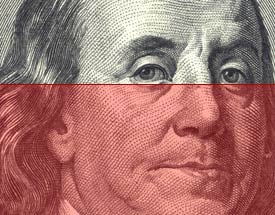 Starting with this post, we'll be updating you every month on the status of the taxpayer-funded bailouts we track in our database -- namely the TARP and government rescue of Fannie Mae and Freddie Mac.
Starting with this post, we'll be updating you every month on the status of the taxpayer-funded bailouts we track in our database -- namely the TARP and government rescue of Fannie Mae and Freddie Mac.
Recentreports have drawn attention to the billions in revenue that the Treasury Department has collected from companies early in returning their TARP investments. While those returns have been encouraging, there's no question that the taxpayer remains deep in the red.
In total, $392.6 billion remains outstanding to 641 recipients ($297 billion under the TARP and $95.6 billion that's gone to Fannie and Freddie). That total excludes the 35 companies that have returned a total of $71.6 billion.
In August, the Treasury invested $129.8 million in nine banks (see our timeline for more details). It also put $10.7 billion more into Fannie Mae.
The Treasury will likely invest or spend billions more. Fannie and Freddie will probably need billions more in assistance. And two major bailout programs have yet to start shelling out committed funds. Treasury plans to use up to $30 billion for its toxic securities program, which could begin this month. It has also set aside $50 billion for its mortgage modification program, which is already well underway. Under the program, participating loan servicers are only paid subsidies if the loans they modify survive a three-month trial period without defaulting. Forty-two servicers have signed up, and roughly 235,000 trial modifications, of the administration's projected total of up to 4 million, had been started by the end of July.
There is also a major commitment to AIG that may cost taxpayers more. The company has to date received $41.5 billion, but Treasury has committed to providing $28 billion more if it's needed.
That said, money is flowing in as it's flowing out. The TARP has two main sources of revenue: quarterly dividend or interest payments and warrant redemptions. Unlike returned money, which can be used again, the Treasury is obligated to use that revenue to pay down the national debt.
You can see our catalogue of all dividend and interest payments here. The vast majority of recipients pay a dividend at a rate of five percent annually. Companies that got special aid, like AIG and Citigroup, pay higher rates. So far, bailout recipients have paid $9.6 billion in dividends.
That amount includes the $2.1 billion in dividends paid by Fannie and Freddie. Those payments are a bit of a mirage, however. The rate is set at 10 percent but will jump to 12 percent if the companies miss a payment, so neither has. But since the companies rely on taxpayer money to remain solvent, dividend payments are "effectively funded from equity drawn from the Treasury,” as Fannie Mae stated in a recent regulatory filing (PDF). In other words, until the companies stop losing money, Treasury will continue to pay the dividends to itself.
So far, the Treasury, through refunded TARP investments, has collected $2.8 billion in exchange for its warrants. The stock warrants, which give the U.S. the right to buy equity in the companies at a set price, came as a condition of the investments. When companies refund the Treasury's money, the warrants are either sold back to the company or auctioned off.
Put all that together, and you get a total of $12.4 billion in revenue. Compared to the $392.6 billion in bailout funds still outstanding, it's reason for cooling any thoughts, at least for now, of the taxpayer pulling a profit.



